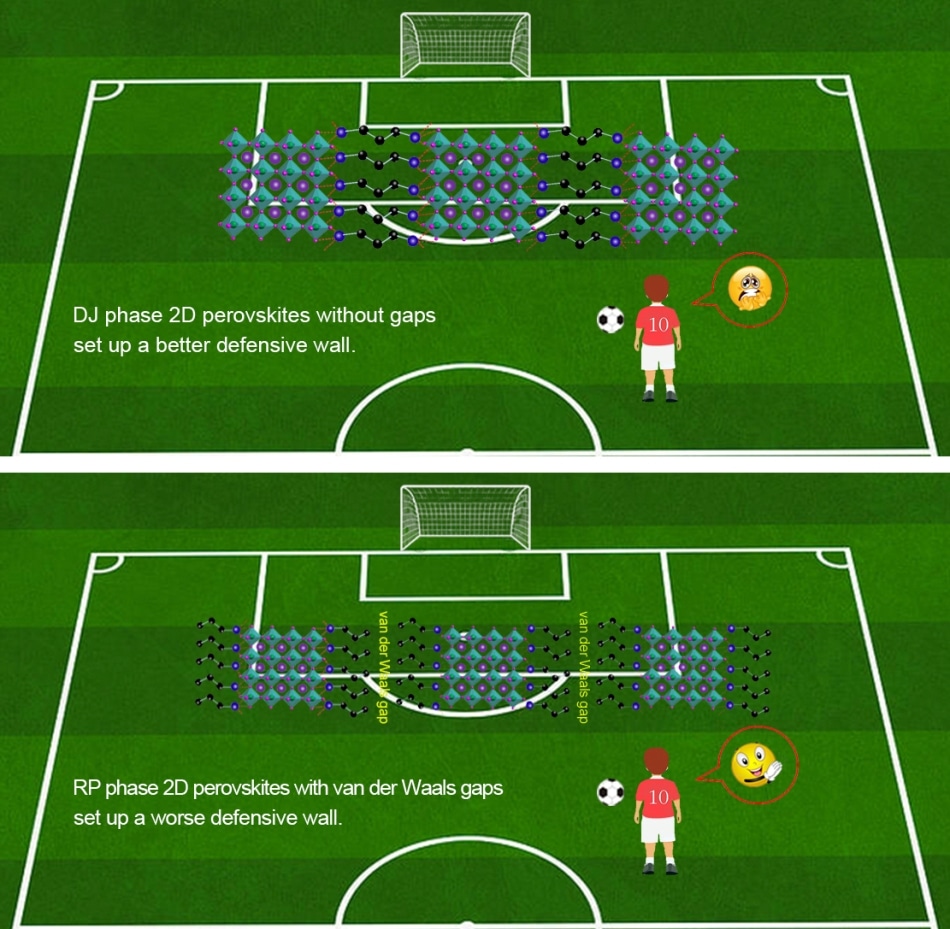Dec 24 2018
It is not known how to set up a defensive wall in a soccer game, and coaches would not prefer a gap between defensive players in the wall. Researchers, on their part, are also doing the same when they attempt to enhance the stability of perovskite solar cells, or PSCs.
 Comparison of RP and DJ phase 2D layered perovskite structures. (Image credit: DICP)
Comparison of RP and DJ phase 2D layered perovskite structures. (Image credit: DICP)
Now, a research team, headed by Prof. LI Can and Prof. GUO Xin from the Dalian Institute of Chemical Physics (DICP) of the Chinese Academy of Sciences (CAS), has successfully enhanced the PSCs’ stability by removing the gaps, known as van der Waals gaps, in extensively researched Ruddlesden-Popper (RP) phase two-dimensional (2D) layered perovskite materials.
The recently fabricated materials are a range of Dion-Jacobson (DJ) phase 2D layered perovskites which, without gaps, possess a highly stable structure and are capable of defending against attacks from light, heat, and moisture in a more efficient way, resulting in excellent stability of PSCs under numerous adverse testing conditions. The study results have been reported in Joule on December 21st, 2018.
It has been shown that PSCs can be a potential candidate for advanced photovoltaics. Yet, their instability tends to restrict more developments because traditional organic-inorganic hybrid perovskites (3D ones) are characterized by poor structural stability and are often utilized as the light-harvesting materials in PSCs.
In the recent past, the 2D layered perovskites have attracted a great deal of research interest because they provide better stability when compared to conventional 3D equivalents. In the majority of cases, the word “2D layered perovskites” refers to RP phase perovskites, wherein van der Waals gaps exist. It is these gaps that generate feeble interactions between layers and thus reduce the stability of the device and the layered perovskite structure.
In contrast with the RP case, our DJ phase 2D layered perovskites are formed by alternating hydrogen bonds between organic layers and inorganic layers with no gaps, which makes their structure more stable. External stresses like moisture, heat and light cannot easily degrade such materials. This is just like a defensive wall in a soccer game. Imagine that each defensive player is an organic layer or an inorganic layer in 2D layered perovskites. If they stand next to each other in a row, the kicker cannot easily make a goal. If there are gaps between players in the wall, the kicker can score easily, which is just like the situation in RP 2D layered perovskites.
GUO Xin, Professor, Dalian Institute of Chemical Physics, Chinese Academy of Sciences.
To degrade DJ phase 2D perovskites than their RP analogs, additional energy from external stresses is required. Just like a soccer game, a good defensive wall can only be bypassed by making a banana kick; hence, it is more challenging for the kicker.
Indeed, the PSCs fabricated using our materials exhibited more outstanding stability than those using 3D and RP phase 2D perovskites. Our unsealed devices can maintain 95% of initial efficiency upon exposure to various harsh stresses, including being stored in ambient air for 4,000 hours, heated at 85 oC with relative humidity of 85% for 168 hours, and continuously illuminated for 3000 hours.
LI Can, Professor, Dalian Institute of Chemical Physics, Chinese Academy of Sciences.
“The highest efficiency we obtained from the PSCs made from our 2D perovskites is just over 13%. Although this is one of the highest values among 2D PSCs, it lags behind the state-of-the-art efficiency of 3D PSCs. Therefore, more effort needs to be made to further improve the efficiency of these 2D PSCs,” stated the DICP scientists in their report.